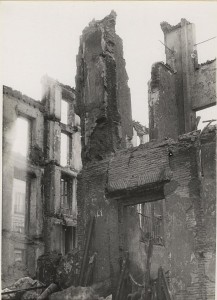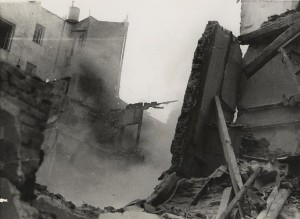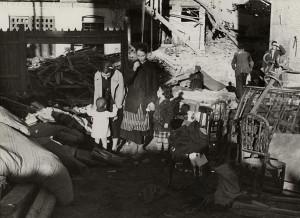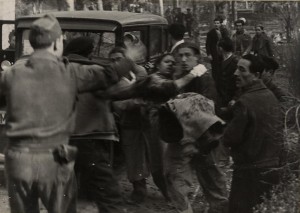Bombs Over Madrid
Translator’s Note: Louis Delaprée published “Madrid sous les bombes” in Marianne on 25 November 1936 under the pseudonym Jean Roget. There is no doubt as to its authenticity, cf. Marianne, 16 December 1936, which specifically acknowledges his authorship. Arturo Barea wrote that the title of a censored report by Delaprée was J’accuse, which had unmistakable echoes of the Dreyfus affair (La Forja de un rebelde, Barcelona, Debate, 2003 edn, p. 735). Was this Delaprée’s preferred title? This is a new translation and I have made no use of the anonymous version published in The Martyrdom of Madrid in 1937. (Click here for an extended essay on Delaprée and the impact of his work on Picasso.)
What follows is not the laying of charges.
It is a recording secretary’s deposition.
I catalogue the ruins, count the dead, weigh up the spilled blood.
I have seen all these images of the martyred city of Madrid that I will try to show you, although mostly they defy description.
I do not care for propaganda tracts or watered-down diplomatic reports, nor do I obey the dictates of political parties or Churches. I can be believed. I ask you to believe me.
This is my testimony. You will judge for yourselves.
* * *
The first real bombing of Madrid was on the 4th of November, when the siege of the capital began in earnest.[1] However, it was not until the 16th of November that the systematic killing of the civilian population began.
In previous days, many women and children had been killed, especially near the aerodrome of Cuatro Caminos.[2] This was the reality of war. Blind artillery ought to spare the innocents and kill armed men. So no-one thinks of protesting, or getting worked up, if a shell pulverizes an old woman who was herding her goats at a kilometre from the line of fire. That’s what we call war…
But something very different happened on the night of the sixteenth…
***
The darkness shrouding Madrid is so thick that you could cut it with a knife. We cannot see the sky, but from the sky they can see us.
Humming, rumbling, pounding… The rebel planes appear in an awesome crescendo. Pro-government fighter planes cannot pursue them in this darkness.
Defenceless, we hear above our heads the deep musical vibration that is the herald of Death.
Blasts, cushioned and then ear-splitting…
Window-panes rattling almost inaudibly…
Windows thrown open by an invisible force…
And all the sounds that will soon become familiar to us. The trampling of people as they escape, the sirens of ambulances transporting the wounded, the sobbing of women beside you as they bury their heads in their scarves, the to-and-fro of men who click their heels to convince themselves that they are not afraid…
And above all – above all else – the sound of your own heart pounding ever faster…
The first bombs destroy the Provincial Hospital and the Hospital of San Carlos.
The elderly who can still fend for themselves rush out of the dormitories and jostle down the stairs, huddle in the depth of the cellars, fiercely dispute the ‘best places’ with all their diminished strength.
The disabled, the sick, slide to the floor and hide under their beds. Next morning, five or six of them have gone mad and have to be dragged away from their flimsy shelters.
Bombs rain down continuously on the whole area between the Cortes, Atocha Station and León Street.
In San Agustín Street, a missile has sliced a house open from top to bottom, like a plough cutting through earth. As it burns, the flames spread to the house opposite. Was it aimed at the Palace Hotel, where thousands lie wounded?[3] I don’t know. But four hits encircle it. The blast from the explosions shatters windows a centimetre thick. As at the San Carlos Hospital, men throw themselves out of their beds and try to escape, bandages come undone, wounds re-open…
An incendiary bomb falls on the roof of the French Embassy in Villalar Street. The fire is put out in time, but the surrounding buildings burn like torches. At five in the morning, the street is still in flames.
A terrible confusion reigns in the night, as it is lit up by deadly flares. We stumble against the stretchers, knock into the wounded who watch as their blood flows on the asphalt by the light of the flames.
On the corner of Alcalá and Gran Vía, a hand clutches my leg. I free myself and light a match while I bend over the person who has grabbed this lifesaver. It’s a young woman, her nose already pinched by approaching death. I don’t know what her wounds are, but her robe is stained with blood. She whispers:
“Look, look what they’ve done…”
And her hand makes an indeterminate gesture. Another match.
“Look, look”, the voice says again.
The bloodless hand is still showing me something. At first, I think it’s the pool of blood on the sidewalk.
“Look…”
I bend again, and I perceive a small child, lying crushed under broken glass.
The white hand calls on the sky to bear witness and drops again.
Another match. With my companion, Flasch[4], of the Journal, who has joined me, we bend over the wounded woman.
“She’s dead”, he says.
It’s true. Her last breath and death throes have opened up her robe. A terrible wound, looking as though it had been inflicted by a sadist’s knife, has opened up her body from her left breast to the right hip.
An ambulance passes by slowly. We hail it. Is that a man getting down? The beam from an electric flashlight illuminates the corpse.
“Dead”, the man says drily, “they’ll pick her up tomorrow. The wounded first.”
He sees the child’s body, which is still in the road and might get crushed again. So he adroitly removes the broken glass, picks up the tiny corpse and places it on the woman’s heart, next to the right breast, which is unharmed. A final flicker of the flashlight shows us the small infant’s head on that maternal heart and everything sinks back into the night.
The whole city is full of similar scenes, of comparable pictures that seem to have been conjured up on the whim of a macabre genius, a necrophilous god. I have painted this scene in some detail because it was the first that showed me the reality of this butchery, and not the abstract and victim-free bombing from which I fled, like everybody else in the tortured city.
And there again, how could I forget the image of this dead child on a dead woman’s breast in a pool of black blood?
***
The next day was worse. As it turned out, that night had been no more than a dress rehearsal.
The flight squadrons came at five o’clock in the morning. (Madrid was still treating its wounded and collecting the corpses.) They returned at eight, at nine, and then at half past three. It was a job well done, a thorough and meticulous bombing of all the central districts. The San Miguel market, the Red Cross Hospital and Marqués de Urquijo Avenue have been devoured. The bombs explode everywhere: in Martín de los Heros, San Marcos, Monteleón…
By lunchtime, just over three hundred dead were already on the slate.
The rebels strengthen the aerial bombardment – no doubt considered insufficient – by launching artillery fire.
Six 75mm shells hit the Telephone Exchange, which rises fifteen stories[5] above Madrid, yet miraculously none explode. Nor does a 155mm shell that slides into the small switchboard exchange.
The building shakes under the pressure. But no-one moves: the girls, their earphones on, go on marking the connections, the journalists try to get through to London or Paris.
Unfortunately, we cannot say that the explosives in the rest of the city are so accommodating. They explode, thunder, shatter, slaughter. Ambulances endlessly scour the streets in all directions, renewing their cargo of wounds and suffering once they have unloaded the previous haul at a hospital. But night falls. And then the butchery begins, the horror of the Apocalypse: the assassins wheel endlessly around the sky, releasing explosives, incendiary bombs and shrapnel.
A bomb falls into the subway entrance in the Puerta del Sol, near Alcalá, tearing up the road and sinking a crater fifteen metres deep. In San Jerónimo, a chasm opens up across the full width of the street. From 20 different places, the fire starts to consume the city.
I am near the Carmen Market with two colleagues when the bombardment begins. Three bombs, two of them incendiary shells, fall close by. Crouching in a doorway, we see how the little market stalls catch fire, lighting up the frantic flight of men, women and children.
During a brief lull, we dash to the Telephone Exchange.
From this extraordinary vantage point, the sight is one of unthinkable horror. A circle of flames converges on Gran Vía with majestic slowness. We observe how rooftops catch fire, and houses burn downwards before crashing heavily amidst a splendor of sparks and flames. Some burnt-out buildings remain upright, like tall sinister figures, licked by reflections from the fire that continues its work further away.
The firefighters stop hosing these thousands of homes. In any case, the enemy planes make their task impossible. When they see them aiming the extinguishers, they fly very low, just above the fire, dropping a couple of explosive bombs to teach a lesson to these firefighters who are only trying to fulfill their duty.
A dozen of these valiant men were killed in this way, as they tried to put out the fire at the Savoy hotel, and fell from the top of their ladders into the flames.
Nothing can be done about it. We can only wait until the rain of killer meteorites has ended, wait until there have been enough dead and wounded to slake the thirst of General Franco’s gods.
300,000 people walk the streets, looking for refuge. Mothers retrace their steps to an area in flames, looking for a child who – although they do not know it yet – is nothing but a small heap of ashes. Children, crazed by fear, call for mothers who have been turned into ashes beneath the rubble. A whole people seeks refuge against the wrath from the sky and finds none. From that night on, it turns in circles, incapable of escaping from the horror, accompanied by its mattresses, clocks, resigned donkeys, and the maddened, terrified, clinging children.
Madrid burns for 15 hours, and then the fire tires. There is a lull for a day. But the following night, the 19th, at 2.30 in the morning, the killing is renewed. The fire starts again, we are back in hell.
***
But why go on describing the martyrdom of Madrid, why list the areas of destruction and recount the mass murders. Even horror becomes monotonous.
I would just like to conclude with five reflections.
1 The bombardments have already killed 2,000 civilians, perhaps more.[6]
2 There are no military objectives in the area where the bombardments were at their most intense.
3 Nobody – I repeat, nobody – has seen the famous pamphlets which rebel planes apparently launched to warn the population that they should seek refuge in the Salamanca district.
4 This district is now overcrowded and cannot now receive more than 20,000 people. And there are a million inhabitants in Madrid.
5 About 100,000 people can take refuge in cellars and subways with at least a degree of safety. But there a million human beings in Madrid.
So Death has plenty on its plate.[7]
I have said that I am no more than a recording secretary.
But let me say what I think.
Christ said: “Forgive them for they know not what they do”. I feel that after the slaughter of the innocents in Madrid, we should say: “Do not forgive them for they know right well what they are doing.”[8]
Translation: Martin Minchom. Click here for an extended essay on Delaprée and the impact of his work on Picasso.
[1] The Francoist army had reached the outskirts of Madrid by 4 November 1936, but the full-scale attack began on 7-8 November. There were many aerial bombardments from late October onwards, and the most intense were between 16 and 23 November.
[2] There was no aerodrome in Cuatro Caminos so Delaprée is referring to Cuatro Vientos (or perhaps Getafe). Either way, pace Stradling, the aerial attack on Getafe apparently meant little to Delaprée and his readers.
[3] Hotels were requisitioned for use as hospitals. (The anarchist leader Durruti died in the Ritz.)
[4] I have not traced reports by Flasch (or Flash), but his presence in Spain is corroborated by the testimony of Delaprée’s boss, Pierre Lazareff.
[5] Le martyre de Madrid (but not Marianne or Mort en Espagne) had the probable interpolation for French readers (p. 25) that it had fifteen stories like an American sky-scraper, and two more at the top in Spanish baroque style.
[6] Delaprée’s figure is almost certainly too high.
[7] After this sentence, Le martyre de Madrid (but not Mort en Espagne) has the probable interpolation (p. 28): “And now that I am a recording secretary, as I said at the beginning, I wish to give my opinion without forcing it on anyone.”
[8] Marianne removed the final lines, after “on its plate”.


















We need this clarity of vision and absence of cant now more than ever. Alerta antifascistas.
[…] deberían leer la descripción de una escena nocturna que Louis Delaprée hizo en su reportaje Madrid bajo las bombas. Una linterna ilumina al niño muerto en los brazos de una mujer herida con el pecho abierto en […]
[…] (La traducción es de Minchom; el original francés de la crónica se puede consultar aquí; ver aquí para una traducción al […]
[…] (La traducción es de Minchom; el original francés de la crónica se puede consultar aquí; ver aquí para una traducción al […]